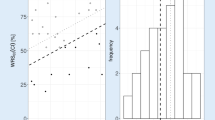Abstract
Objectives
The use of standardized outcome parameters is essential for the comparability of clinical studies. Pure-tone audiometry and speech audiometry are widely used, but there is no systematic evaluation of the outcome parameters in clinical application. Nevertheless, there is presumably a great heterogeneity especially in the field of speech audiometry. This study presents a snapshot of the current situation of documentation and usage of outcome parameters in otologic research.
Study design
Retrospective study of existing literature analyzing common speech audiometric test material and procedure
Main outcome measures
Intervention Studies from 2012 to 2016 concerning hearing ability were eligible for evaluation. Studies were analyzed with regard to study design, pathology and intervention, speech audiometric parameters, pure-tone audiometry, implementation of reporting standards and journal related data.
Results
279 studies were included. Over 50% of the analyzed studies lacked proper documentation. In the remaining studies, there was a broad variance concerning the documented speech audiometric parameters, most often with a fixed presentation level of 65 dB SPL.
Conclusion
The lack of generally used standards for reporting hearing outcomes makes it difficult to compare results of different clinical studies. An adequate description of the methods would be a first and important step in improving reports on audiological outcomes.





Similar content being viewed by others
References
Thorp MA, Shehab ZP, Bance ML, Rutka JA (2003) The AAO-HNS Committee on Hearing and Equilibrium Guidelines for the diagnosis and evaluation of therapy in Meniere’s disease: have they been applied in the published literature of the last decade? Clin Otolaryngol Allied Sci 28:173–176. https://doi.org/10.1046/j.1365-2273.2003.00687.x
Lailach S, Zahnert T, Neudert M (2017) Data and reporting quality in tympanoplasty and ossiculoplasty studies. Otolaryngol Head Neck Surg 157:281–288. https://doi.org/10.1177/0194599817707719
AAO-HNS (1995) Committee on hearing and equilibrium guidelines for the evaluation of hearing preservation in acoustic neuroma (vestibular schwannoma): committee on hearing and equilibrium. Otolaryngol Head Neck Surg 113:179–180. https://doi.org/10.1016/S0194-5998(95)70101-X
AAO-HNS (1995) Committee on hearing and equilibrium guidelines for the evaluation of results of treatment of conductive hearing loss. Otolaryngol Head Neck Surg 113:186–187. https://doi.org/10.1016/S0194-5998(95)70103-6
Gurgel RK, Jackler RK, Dobie RA, Popelka GR (2012) A new standardized format for reporting hearing outcome in clinical trials. Otolaryngol Head Neck Surg 147:803–807. https://doi.org/10.1177/0194599812458401
Gardner G, Robertson JH (1988) Hearing preservation in unilateral acoustic neuroma surgery. Ann Otol Rhinol Laryngol 97:55–66. https://doi.org/10.1177/000348948809700110
Black B (2003) Reporting results in ossiculoplasty. Otol Neurotol 24:534–542
Davis H (1948) The articulation area and the social adequacy index for hearing. Laryngoscope 58:761–778. https://doi.org/10.1288/00005537-194808000-00002
Lehnhardt E, Laszig R, Hesse G (2009) Praxis der Audiometrie, 9th edn. Thieme, Stuttgart
Martin FN, Champlin CA, Chambers JA (1998) Seventh survey of audiometric practices in the United States. J Am Acad Audiol 9:95–104
Medwetsky L, Sanderson D, Young D (1999) A national survey of audiology clinical practices, Part 1. Hear Rev 6:24–32
Kamm CA, Morgan DE, Dirks DD (1983) Accuracy of adaptive procedure estimates of PF-max level. J Speech Hear Disord 48:202–209
Müller J, Plontke SK, Rahne T (2017) Speech audiometric outcome parameters in clinical trials on hearing improvement. HNO 65:211–218. https://doi.org/10.1007/s00106-016-0298-4
Brandy WT (1966) Reliability of voice tests of speech discrimination. J Speech Lang Hear Res 9:461. https://doi.org/10.1044/jshr.0903.461
Author information
Authors and Affiliations
Corresponding author
Ethics declarations
Conflict of interest
The authors declare that there is no conflict of interest.
Ethical standards
As it is a retrospective study of existing literature, this article does not contain any studies with human participants performed by any of the authors. Therefore, an institutional ethic board review was not required.
Additional information
Publisher's Note
Springer Nature remains neutral with regard to jurisdictional claims in published maps and institutional affiliations.
Rights and permissions
About this article
Cite this article
Morgenstern, J., Lailach, S., Zahnert, T. et al. Outcome parameters in speech audiometry: retrospective analysis of data and reporting quality in clinical studies. Eur Arch Otorhinolaryngol 277, 669–677 (2020). https://doi.org/10.1007/s00405-019-05734-9
Received:
Accepted:
Published:
Issue Date:
DOI: https://doi.org/10.1007/s00405-019-05734-9




